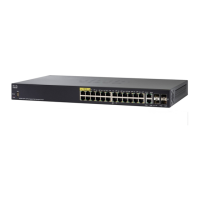IP System Management Commands
541 Cisco Sx350 Ph. 2.2.5 Devices - Command Line Interface Reference Guide
26
Example
The following example displays logging in to IP address 176.213.10.50 via Telnet.
switchxxxxxx>
telnet
176.213.10.50
26.4 traceroute
To display the routes that packets will take when traveling to their destination, use
the traceroute EXEC mode command.
Syntax
traceroute ip {
ipv4-address | hostname
} [size
packet_size
] [ttl
max-ttl
] [count
packet_count
] [timeout
time_out
] [source
ip-address
]
traceroute ipv6 {
ipv6-address | hostname
} [size
packet_size
] [ttl
max-ttl
] [count
packet_count
] [timeout
time_out
] [source
ip-address
]
Parameters
• ip—Use IPv4 to discover the route.
• ipv6—Use IPv6 to discover the route.
•
ipv4-address
—IPv4 address of the destination host.
•
ipv6-address
—IPv6 address of the destination host.
•
hostname
—Hostname to ping (Length: 1-158 characters. Maximum label
size for each part of the host name: 58.)
• size
packet_size
—Number of bytes in the packet not including the VLAN
tag. The default is 64 bytes. (IPv4:64-1518, IPv6: 68-1518)
• ttl
max-ttl
—The largest TTL value that can be used. The default is 30. The
traceroute command terminates when the destination is reached or when
this value is reached. (Range: 1–255)
• count
packet_count
—The number of probes to be sent at each TTL level.
The default count is 3. (Range: 1–10)
• timeout
time_out
—The number of seconds to wait for a response to a probe
packet. The default is 3 seconds. (Range: 1–60)

